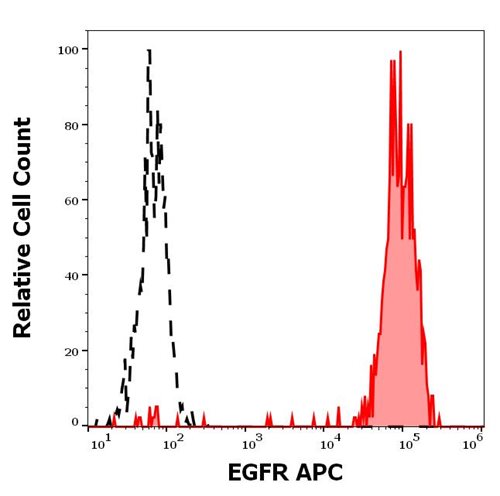Recombinant Mouse NKG2D Ligand 1/NKG2DL/ULBP1 (C-6His)(Discontinued)
Shipping Info:
For estimated delivery dates, please contact us at [email protected]
| Amount : | 50 µg |
| Content : | Lyophilized from a 0.2 µm filtered solution of 20mM PB, 150mM NaCl, pH 7.4. |
| Storage condition : | Lyophilized protein should be stored at -20°C, though stable at room temperature for 3 weeks. Reconstituted protein solution can be stored at 4-7°C for 2-7 days. Aliquots of reconstituted samples are stable at -20°C for 3 months. |
| AA sequence : | PRIEETASLCNIYKVNRSESGQHSHEVQGLLNRQPLFVYKDKKCHAIGAHRNSMNATKICEKEVDTLKDGIDIFKGLLLHIVQETNTTGKPLTLQAEVCGQYEVDKHFTGYAIVSLNGKNIFRVDTSTGNWTQLDHEFEKFIEMCKEDKVLAAFLKKTTEGDCRTWLDELMLHWKEHLEPAGSFSTVDHHHHHH |
Source: Human Cells.
MW :22.3kD.
Recombinant Mouse NKG2D ligand 1 is produced by our Mammalian expression system and the target gene encoding Pro26-Thr211 is expressed with a 6His tag at the C-terminus. Mouse ULBP1, also known as RAET1I and NKG2DL1, is a member of the ULBP/RAET1 gene family. ULBP1 plays an important role in immune responses, especially in cancer and infectious diseases, and is well-known to bind to NKG2D together with at least ULBP 2 and 3. These proteins are distantly related to major histocompatibility class I (MHC I) molecules, possessing the alpha 1 and alpha 2 Ig-like domains, but lacking the alpha 3 domain. Unlike MHC Class I, they have no capacity to bind peptide or interact with beta2-microglobulin. It can activate multiple signaling pathways in primary NK cells, gamma delta T cells, and CD8+ alpha beta T cells, resulting in the production of cytokines and chemokines.ULBP1 is expressed in wide range of tissues including heart, brain, lung, liver, bone marrow and some tumor cells, T-cells, B-cells, As an unconventional member of the MHC class I family, ULBP1 is able to interact with soluble CMV glycoprotein UL16 in CMV infected cells. The interaction with UL16 blocked the interaction with the NKG2D receptor, and thus might escape the immune surveillance. Furthermore, UL16 also causes ULBP1 to be retained in the ER and cis-Golgi apparatus so that it does not reach the cell surface. The ULBP1 regulation may have implications for development of new therapeutic strategies against cancer cells.
MW :22.3kD.
Recombinant Mouse NKG2D ligand 1 is produced by our Mammalian expression system and the target gene encoding Pro26-Thr211 is expressed with a 6His tag at the C-terminus. Mouse ULBP1, also known as RAET1I and NKG2DL1, is a member of the ULBP/RAET1 gene family. ULBP1 plays an important role in immune responses, especially in cancer and infectious diseases, and is well-known to bind to NKG2D together with at least ULBP 2 and 3. These proteins are distantly related to major histocompatibility class I (MHC I) molecules, possessing the alpha 1 and alpha 2 Ig-like domains, but lacking the alpha 3 domain. Unlike MHC Class I, they have no capacity to bind peptide or interact with beta2-microglobulin. It can activate multiple signaling pathways in primary NK cells, gamma delta T cells, and CD8+ alpha beta T cells, resulting in the production of cytokines and chemokines.ULBP1 is expressed in wide range of tissues including heart, brain, lung, liver, bone marrow and some tumor cells, T-cells, B-cells, As an unconventional member of the MHC class I family, ULBP1 is able to interact with soluble CMV glycoprotein UL16 in CMV infected cells. The interaction with UL16 blocked the interaction with the NKG2D receptor, and thus might escape the immune surveillance. Furthermore, UL16 also causes ULBP1 to be retained in the ER and cis-Golgi apparatus so that it does not reach the cell surface. The ULBP1 regulation may have implications for development of new therapeutic strategies against cancer cells.
Endotoxin : Less than 0.1 ng/µg (1 IEU/µg) as determined by LAL test.
For Research Use Only. Not for use in diagnostic/therapeutics procedures.
|
There are currently no product reviews
|



















.png)




![Anti-Human Fc epsilon RIa Monoclonal Antibody (Clone: AER-37 [CRA1]) Anti-Human Fc epsilon RIa Monoclonal Antibody (Clone: AER-37 [CRA1])](https://media.abeomics.com/images/30-2937/1.jpg)





